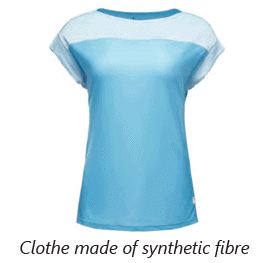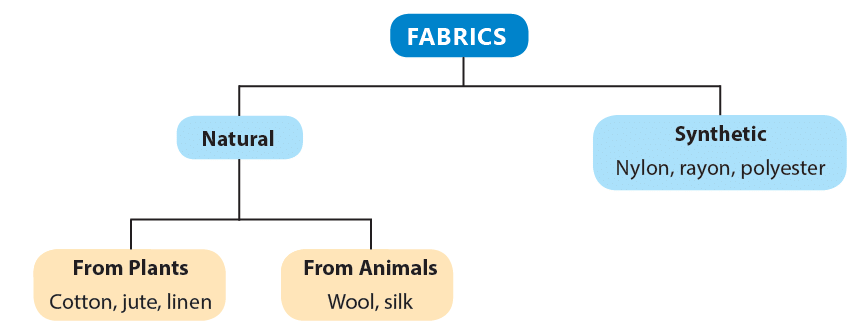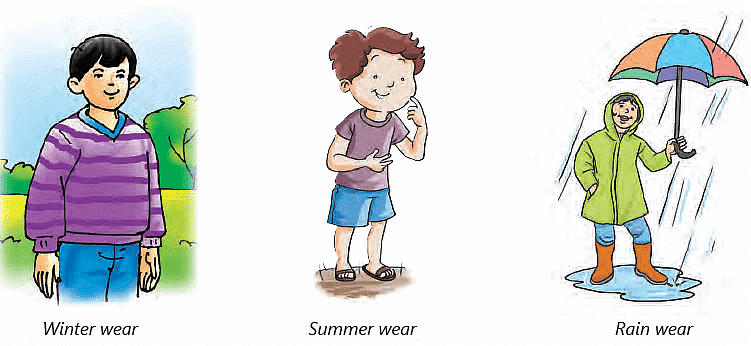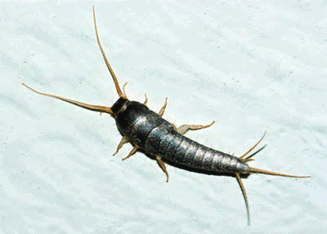Clothes – Our Protection Class 4 Notes Science
| Table of contents |

|
| Introduction |

|
| Why Do We Need Clothes? |

|
| The Clothes We Wear |

|
| Care of Clothes |

|
| Storing of clothes |

|
Introduction
- Early humans used animal hides and tree bark for clothing.
- They progressed to weaving, with Egyptians making linen and Chinese producing silk.
- Clothes were initially draped, not stitched.
- Over time, people learned to weave and stitch clothes for better fit.
- Clothing evolved with dyes, seams, laces, buttons, and other details.
 Ancient Human
Ancient Human
Why Do We Need Clothes?
- Clothes shield us from cold, heat, dust, rain, and insects.
- Different regions wear different types of clothing based on their climate.
- Wool clothes provide warmth in winter, while cotton clothes offer coolness and comfort in summer.
- Clothes serve the purpose of looking good and stylish.
- Clothing should be comfortable, suitable for the weather, and appropriate for our activities.
- They also contribute to our overall appearance, making us look smart and presentable.

Materials Used for Making Clothes
- Use a magnifying glass to inspect different types of cloth.
- Notice the threads or fibers that compose the cloth.
- These fibers are twisted together and create patterns within the fabric.
- Clothing primarily consists of these fibers.
- Machines weave fibers together to form patterns in fabric.
- When your mother knits a sweater for you, she creates patterns using wool fibers with knitting needles instead of machines.

Fibres are of different kinds.
- Natural fibres are fibres obtained from plants and animals. We get fibres such as cotton, jute and linen from plants.


- We get wool and silk from animals. Clothes made from natural fibres have air spaces between them. They absorb sweat and are therefore comfortable, especially in hot weather.
- Synthetic fibres are made by humans from substances called chemicals. They are man-made fibres. Nylon, rayon and polyester are synthetic fibres. Nylon was the first synthetic material to be made. Clothes made from synthetic fibres are stronger. They dry easily. They do not wrinkle easily. But they have less air spaces in them than natural fibres. They also cannot absorb sweat as they are non-porous.

Edurev Tips:
Synthetic fibres catch fire easily. They melt and shrink away in the flame. One should avoid wearing synthetic materials in the kitchen.

The Clothes We Wear
The type of clothes we wear depends on different factors.
Clothes and weather
- Light cotton clothes are ideal for hot weather because they allow body heat to escape and absorb sweat.
- They facilitate air circulation, making them more comfortable.
- White or light-colored clothes are cooler as they absorb less heat compared to dark colors.

- Loose-fitting clothes like kurta-pyjama or lungi are cooler and more comfortable than tight ones.
- In cold weather, wool clothes keep us warm, while leather and fur are worn in very cold places.
- Leather and fur clothes are made from animal skins, not fibers.
- Raincoats, made of waterproof materials like polythene, protect us from rain without absorbing water.
Clothes and Sports
- Sportswear today often uses Dri-Fit material, which is made of polyester.
- Dri-Fit fabric pulls sweat away from the skin to the fabric's surface, where it evaporates quickly.
- This helps athletes stay dry and comfortable during workouts.

- Dri-Fit is particularly effective in hot weather, keeping the body dry, cool, and comfortable.
- Polyester Dri-Fit is chosen over cotton for sportswear because cotton tends to become damp after absorbing sweat and doesn't dry as fast.
Socks and Shoes
- Apart from clothing, we wear socks and shoes to shield our feet.
- Shoes need to be comfortable and properly fitting.
- In summer, we opt for open shoes like flipflops and sandals, while closed shoes are preferred in winter to keep feet warm.

- Rubber boots are suitable for the rainy season.
- Special shoes for walking and running provide necessary support to the feet.
- It's advisable to avoid high-heeled footwear.
- Cotton socks are ideal for comfort.
- Shoes safeguard our feet from injuries and protect them from heat, cold, dust, and germs.

- Walking barefoot can lead to cuts on the feet which might get infected.
- It's important to refrain from wearing dirty socks and tight or wet shoes to maintain foot health
Edurev Tips:
Take a cloth bag with you when you go shopping so that you do not have to take a plastic bag from the shopkeeper. You will help the environment in this way.
Care of Clothes
- Clothes gather dirt from dust and sweat from our bodies.
- Most clothes can be washed with soap or detergent and water, making them clean and fresh after drying and ironing.
- Silk and woolen clothes are often dry cleaned using petrol and other chemicals, though they can also be gently washed at home.
 Care of clothes
Care of clothes - Torn clothes and loose seams should be promptly mended.
- Clothes worn by sick individuals should be disinfected using an antiseptic solution.
- Regular cleaning and proper care help clothes last longer.
Storing of clothes
- During summer, people store away their woolen clothes to prevent damage.
- Improper storage can lead to spoilage by insects like silverfish and moths.
- Clothes are typically cleaned and placed in boxes for protection against moisture, dust, mold, and mildew.
- Moth balls or dried neem leaves are placed between clothing folds to repel insects.
- Boxes containing clothes should be stored in a cool, dry area away from light.
- Blankets and duvets can be either dry cleaned or aired in the sun for a few hours before being stored.
 Silverfish
Silverfish
Edurev Tips:
- Disinfected: Cleaned, especially with a chemical, to destroy bacteria
- Antiseptic: Prevent the growth of disease-causing germs
- Mould: A fungus that can grow in a home in moist warm conditions
- Mildew: Greenish or whitish fungus that grows in warm and wet conditions
|
57 videos|76 docs|59 tests
|
FAQs on Clothes – Our Protection Class 4 Notes Science
| 1. Why do we need clothes? |  |
| 2. How can we take care of our clothes? |  |
| 3. What are some common ways to store clothes? |  |
| 4. How often should we wash our clothes? |  |
| 5. How can we make our clothes last longer? |  |















